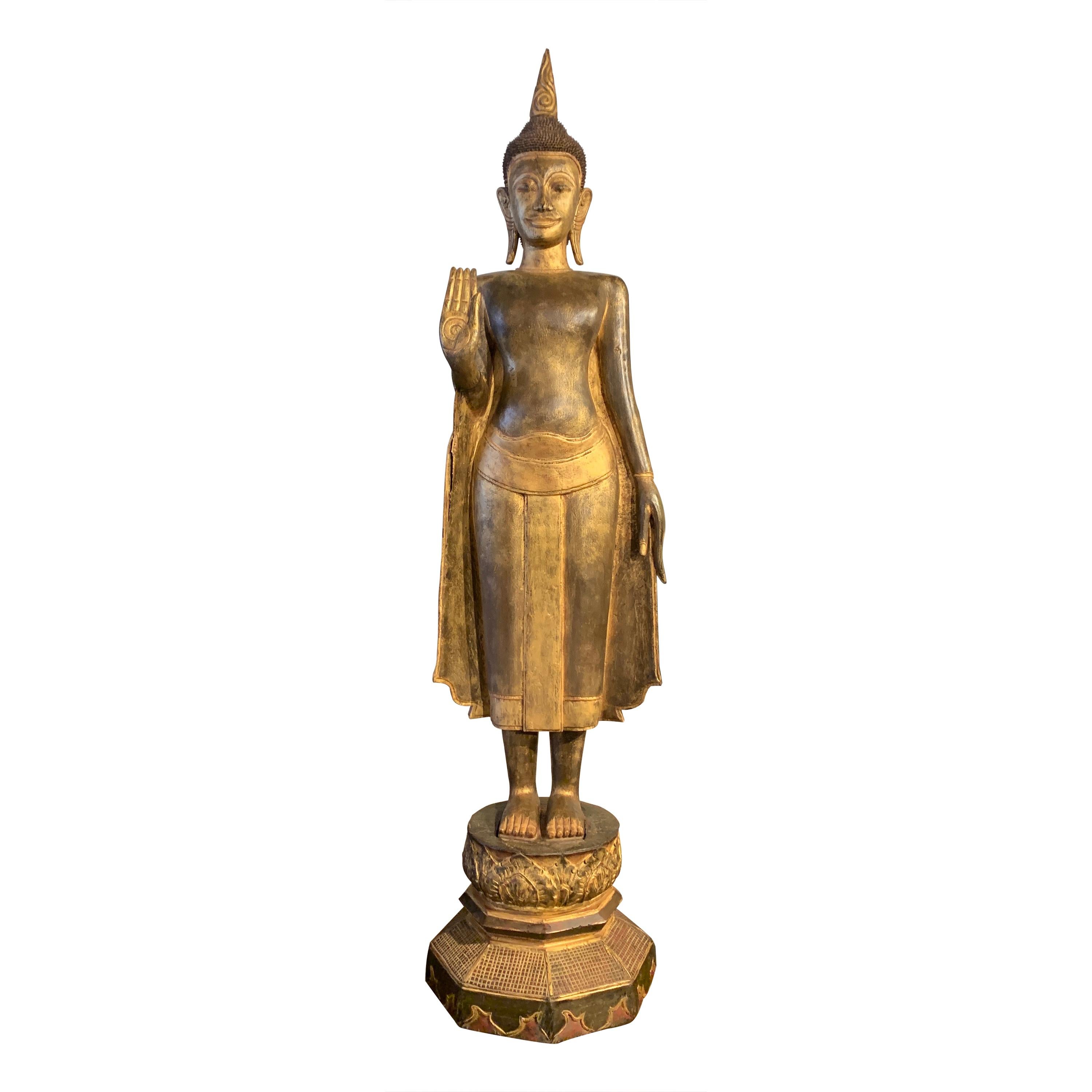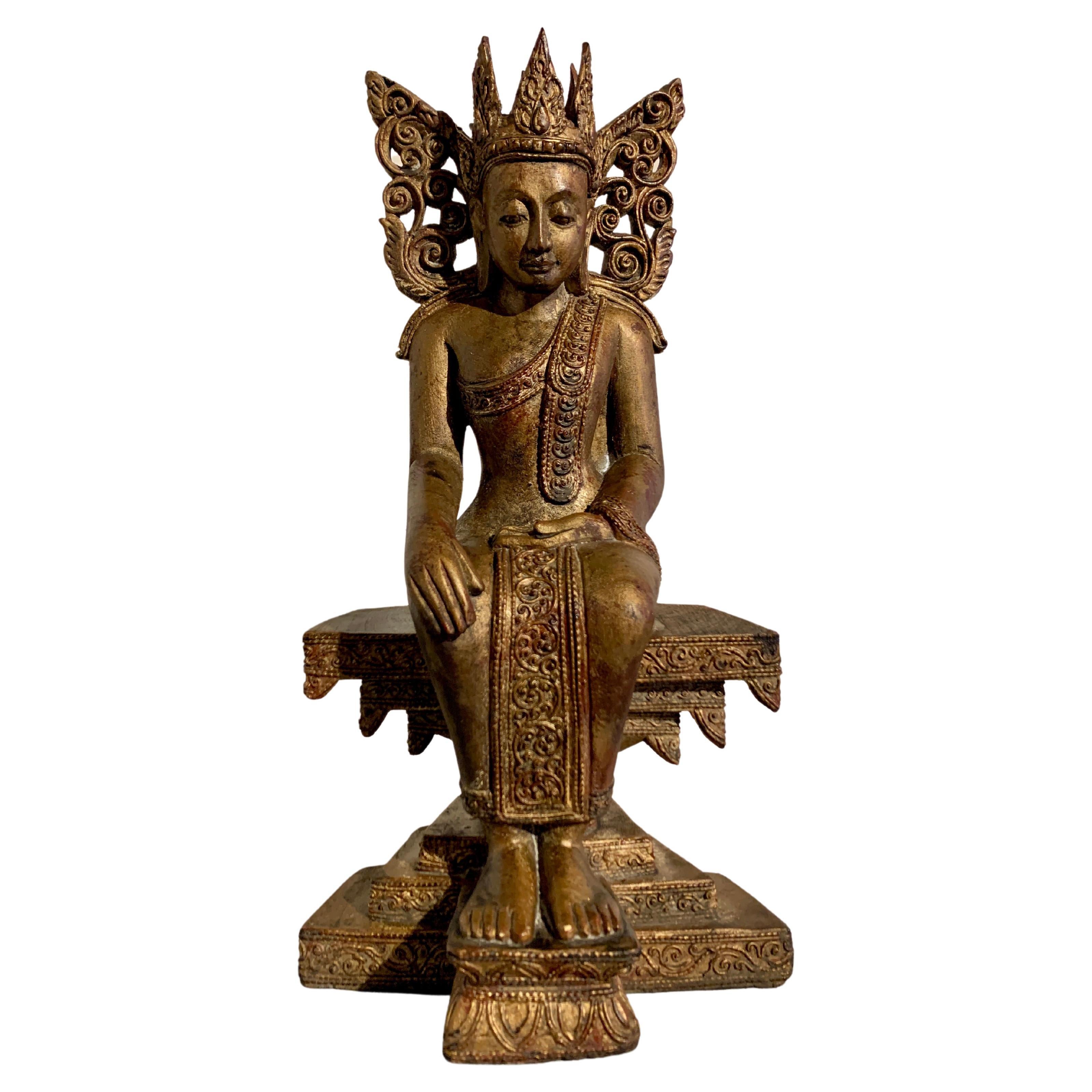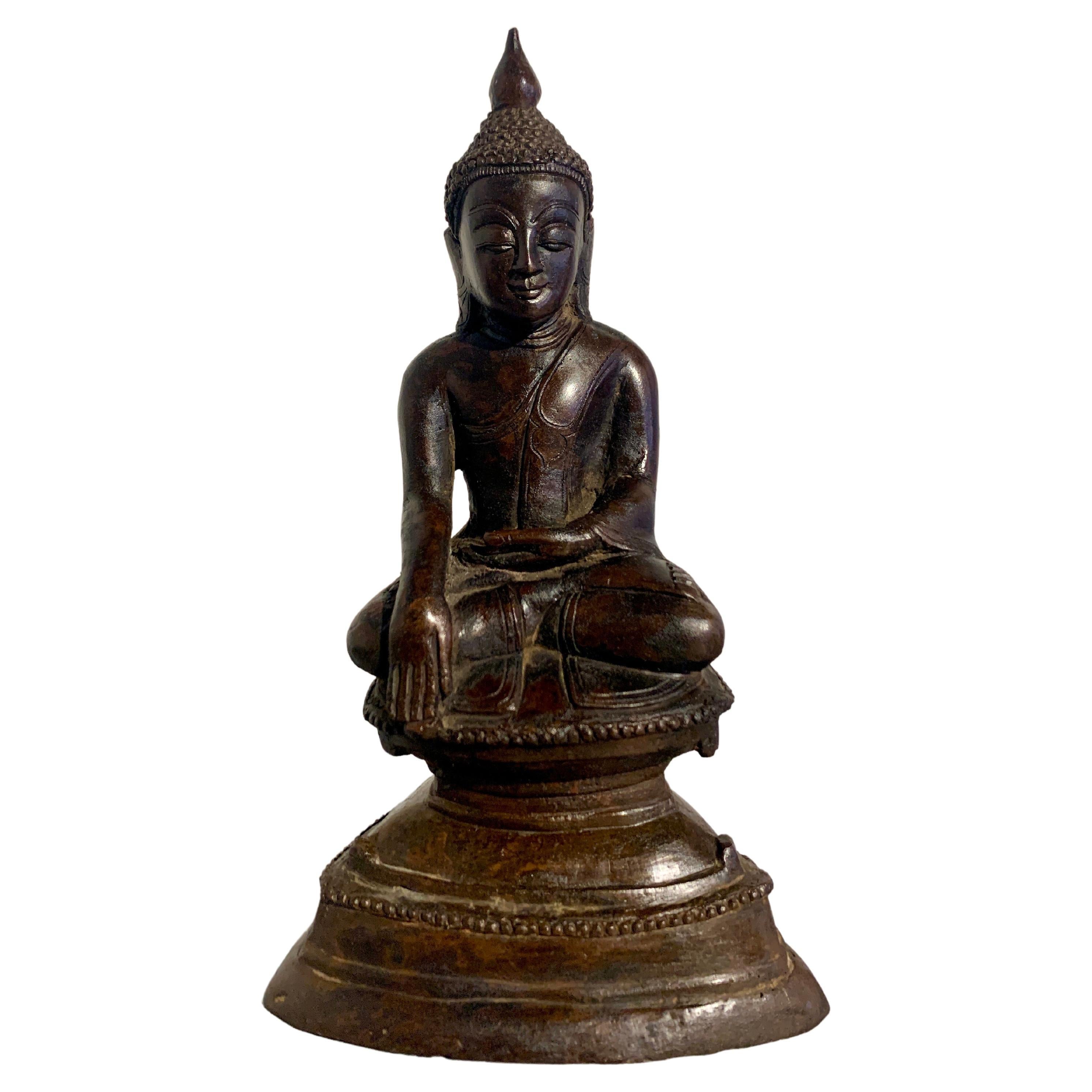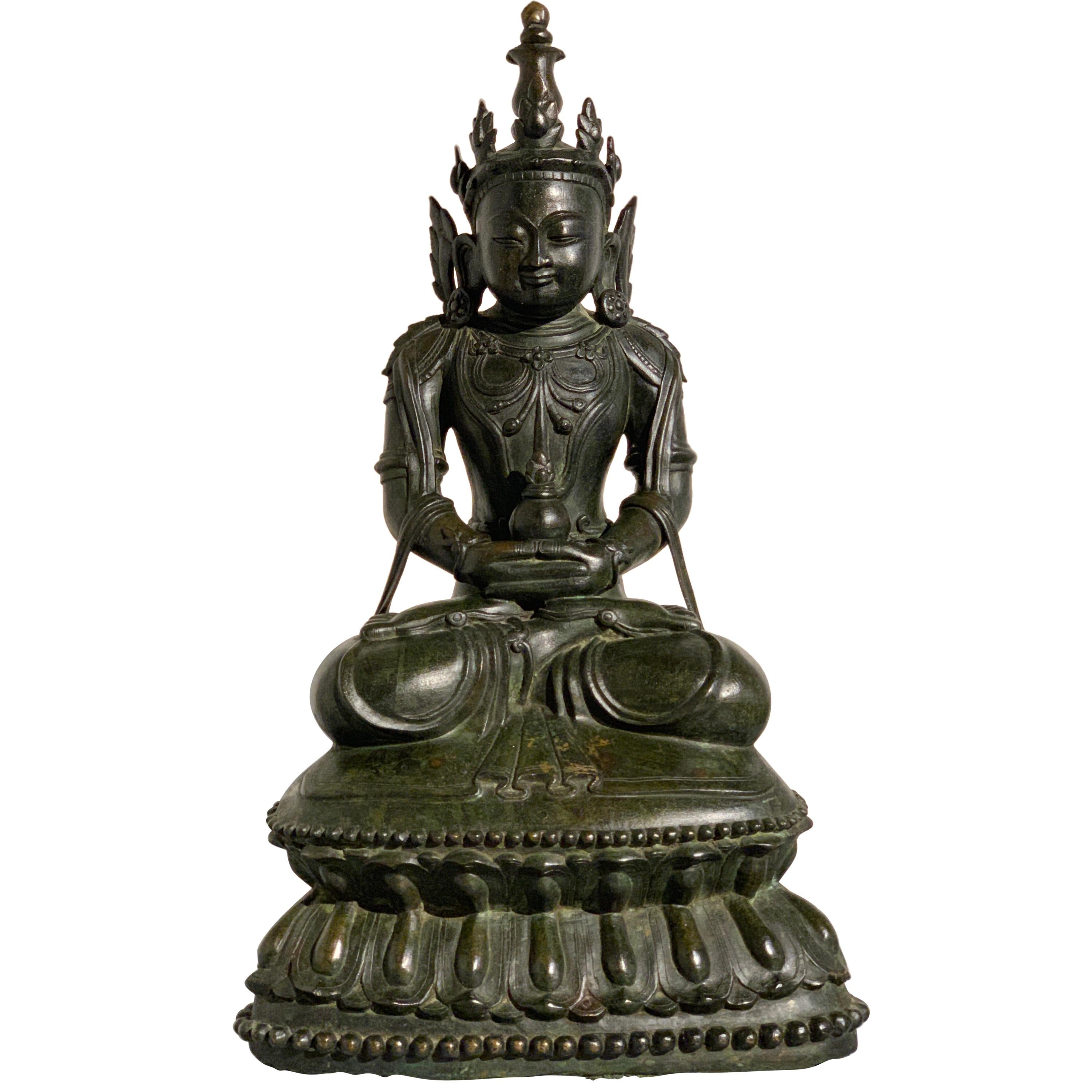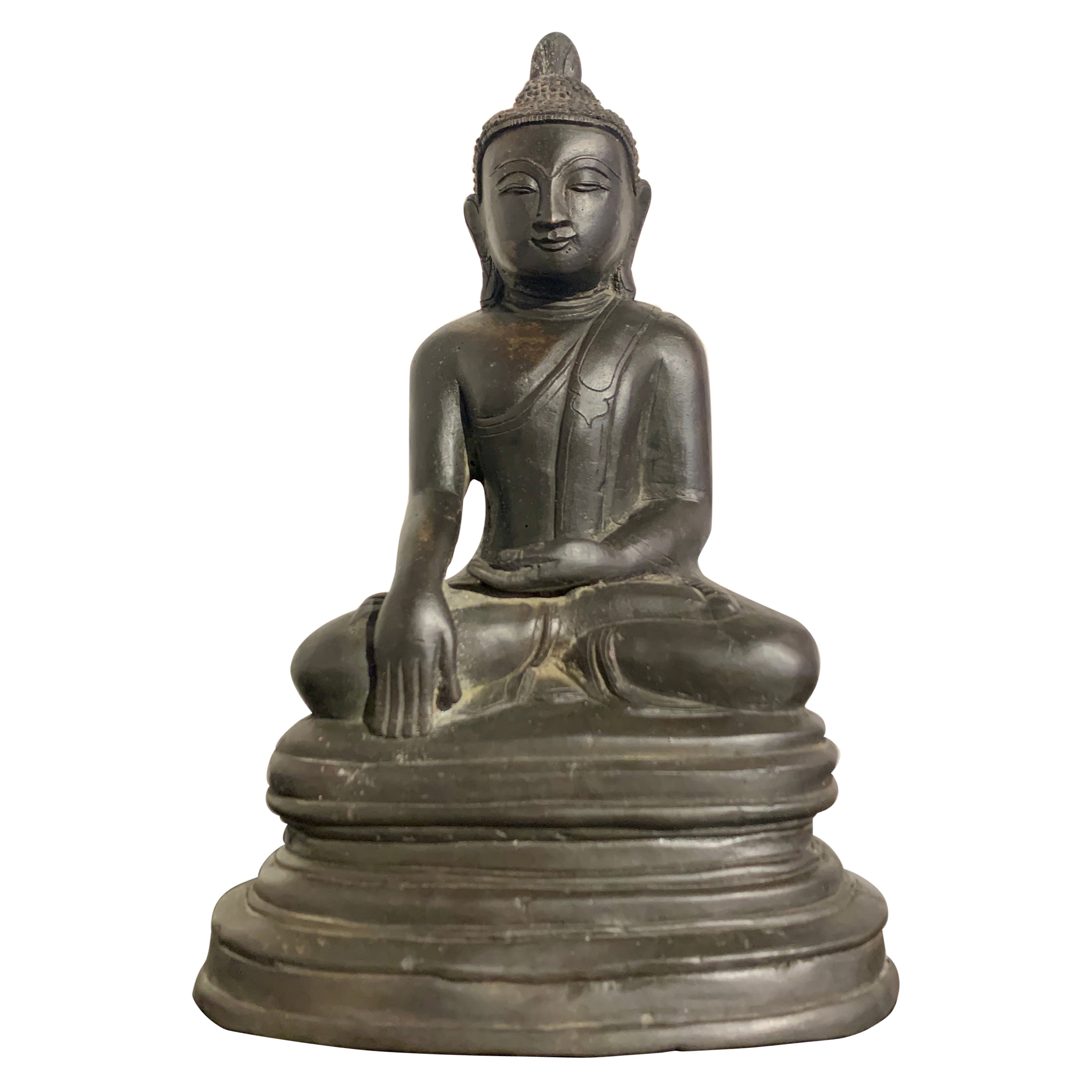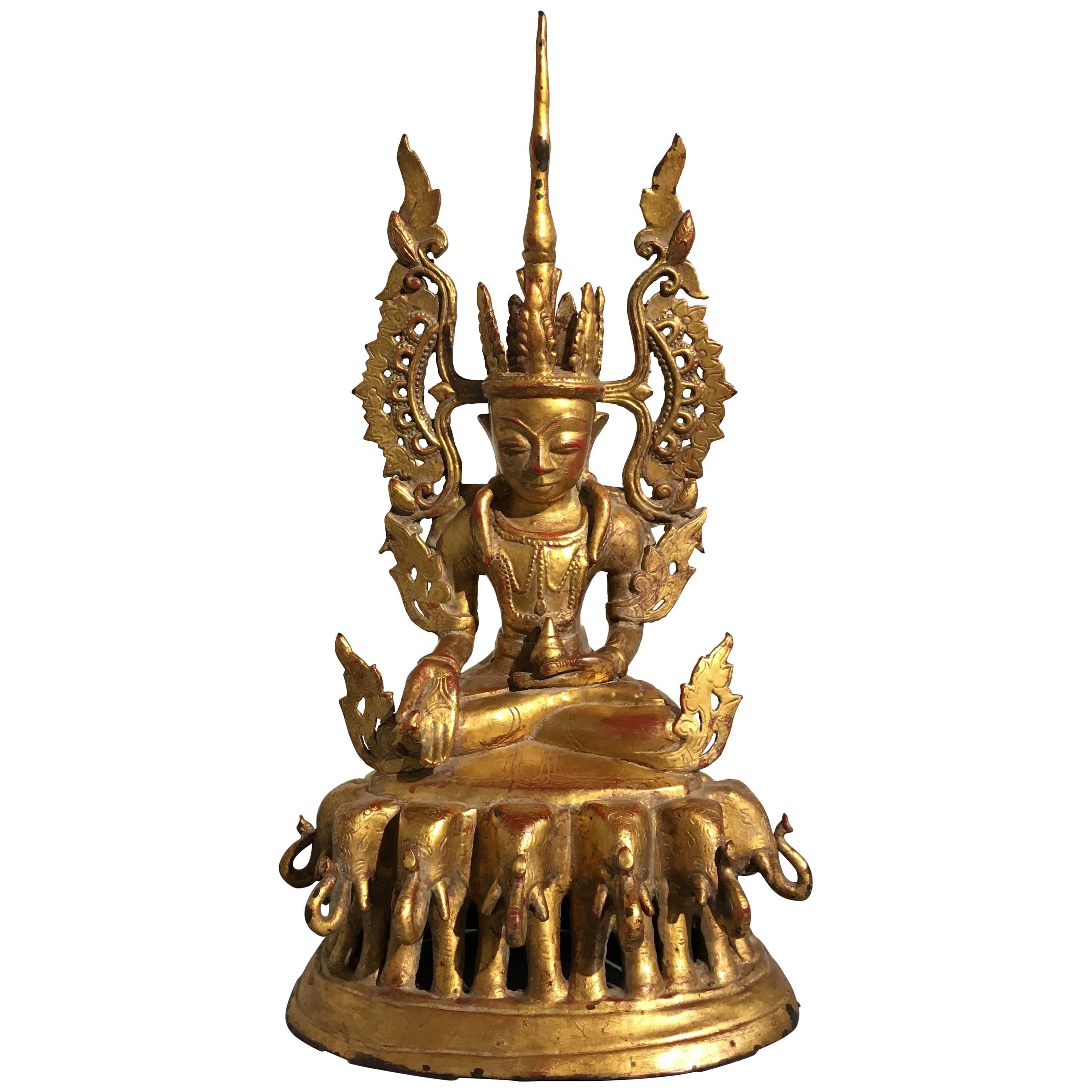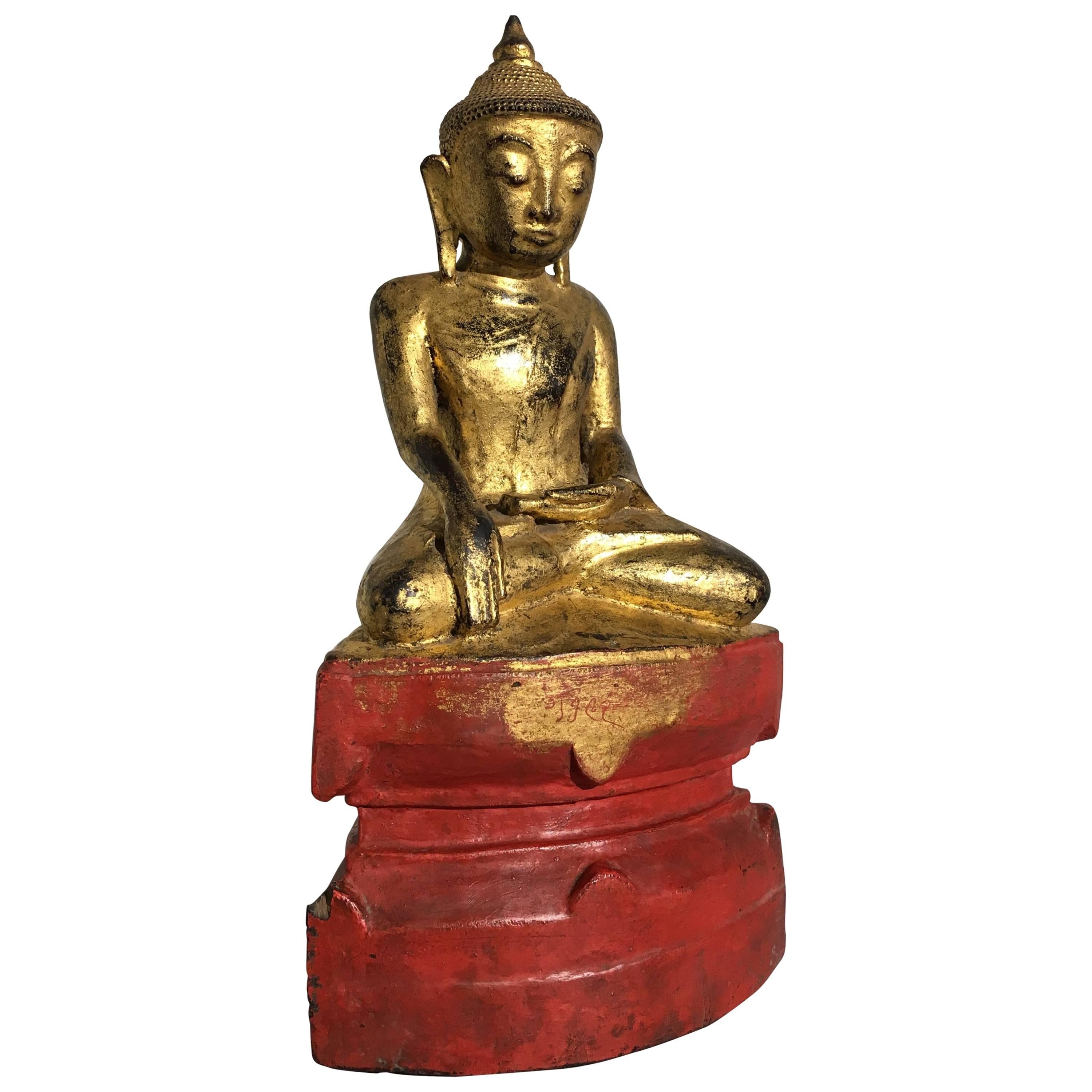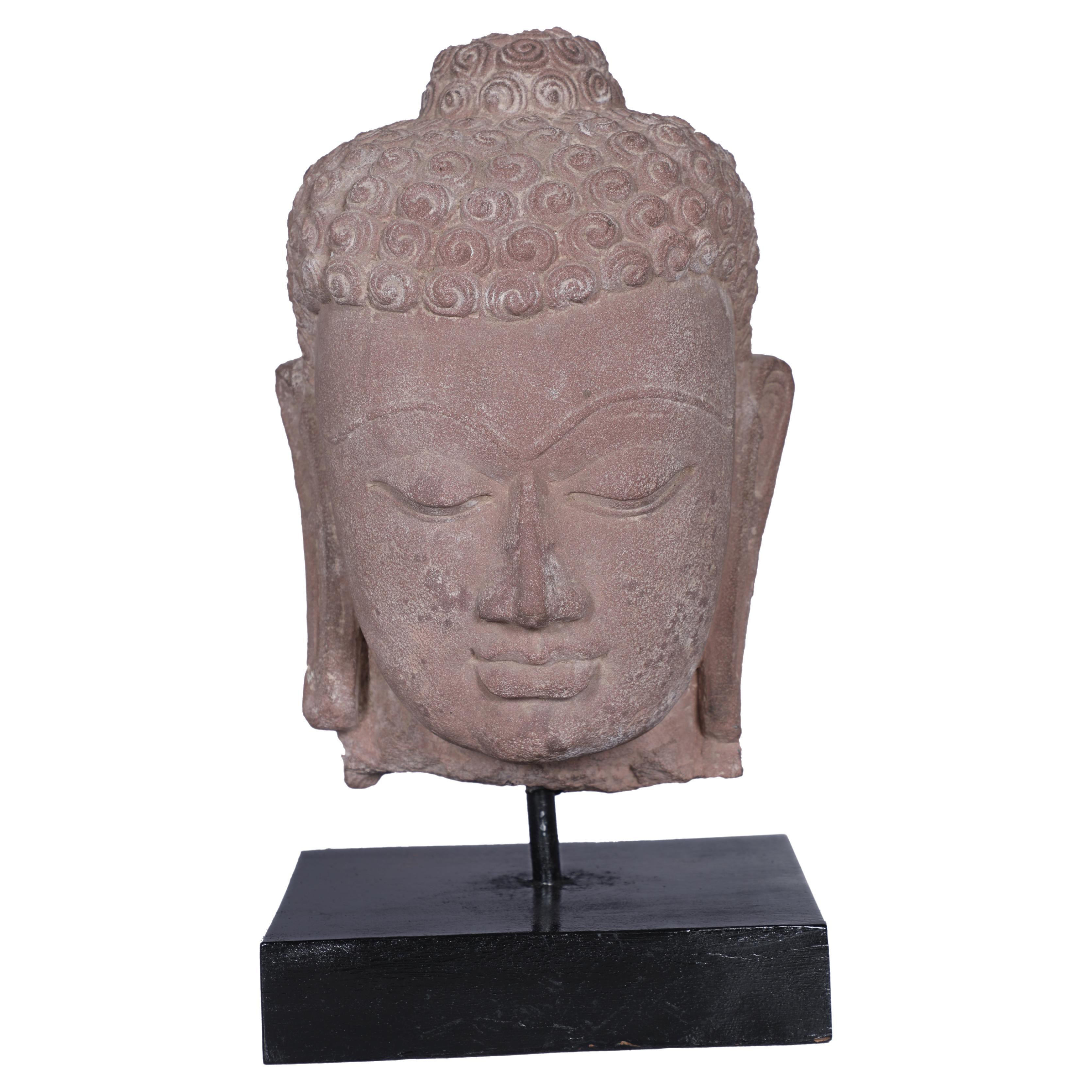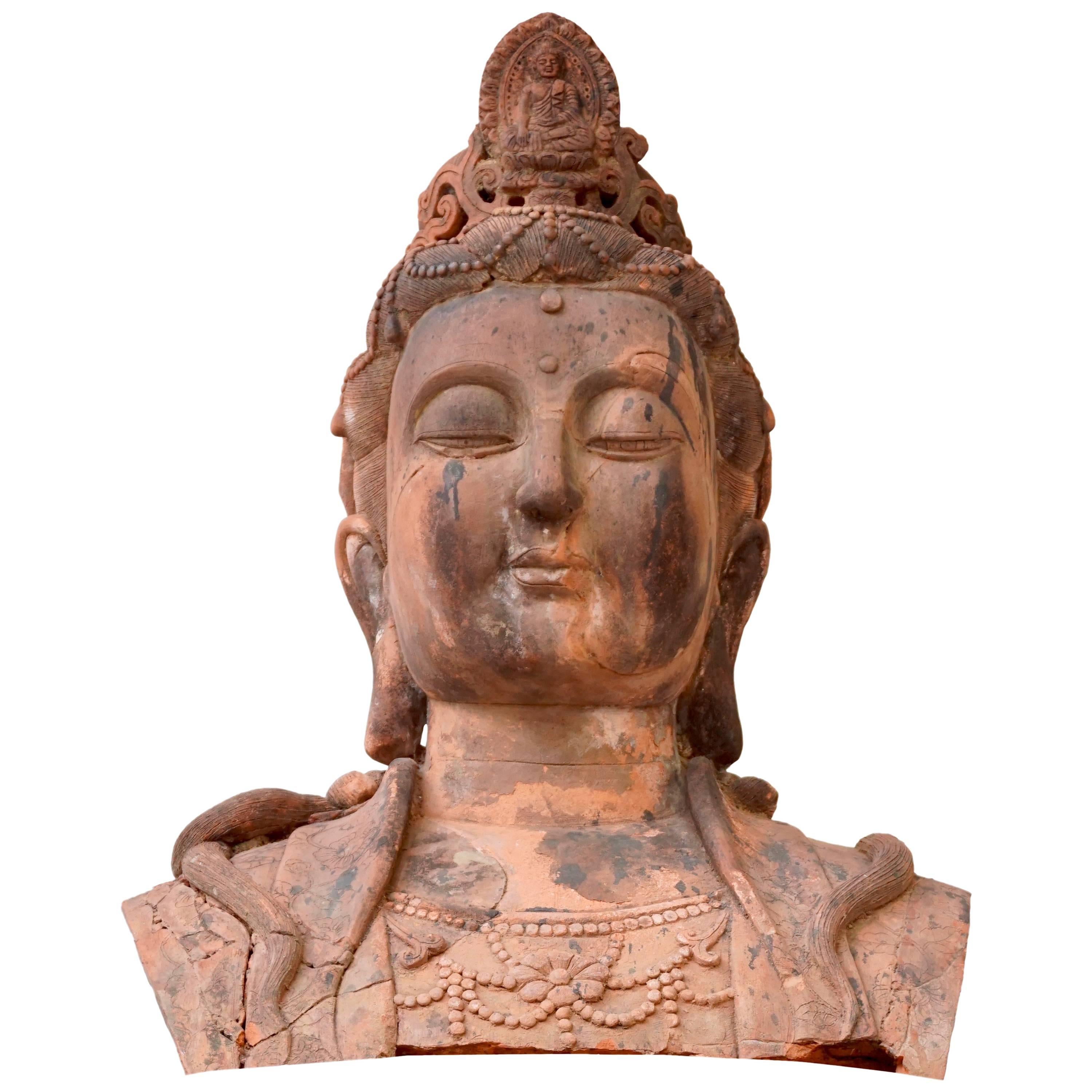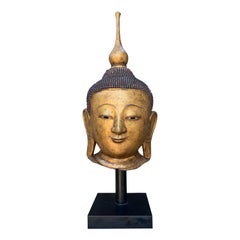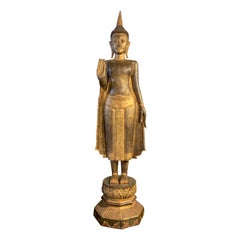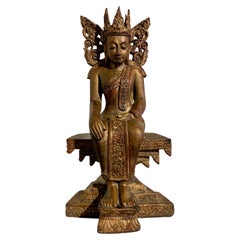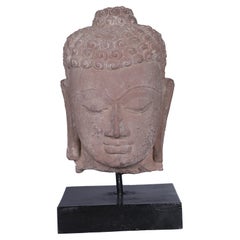
Large Burmese Dry Lacquer Gilt Crowned Buddha, Early 20th Century
View Similar Items
Want more images or videos?
Request additional images or videos from the seller
1 of 11
Large Burmese Dry Lacquer Gilt Crowned Buddha, Early 20th Century
About the Item
- Dimensions:Height: 43.75 in (111.13 cm)Width: 26 in (66.04 cm)Depth: 18 in (45.72 cm)
- Materials and Techniques:
- Place of Origin:
- Period:
- Date of Manufacture:circa 1930
- Condition:Wear consistent with age and use. Minor losses. Minor fading. The lacquer and gilt with some rubbing. The hand in the lap with some cracks at the wrist. Some scattered minor losses the they thayo decoration.
- Seller Location:Austin, TX
- Reference Number:1stDibs: LU89478250393
About the Seller
5.0
Gold Seller
These expertly vetted sellers are highly rated and consistently exceed customer expectations.
Established in 2001
1stDibs seller since 2010
305 sales on 1stDibs
Typical response time: 1 hour
More From This SellerView All
- Monumental Shan Burmese Gilt Lacquer Buddha Head, Early 20th CenturyLocated in Austin, TXA Burmese gilt dry lacquer monumental head of the Buddha, Shan States, Myanmar (Burma), early 20th century. This monumental dry lacquer and gilt head ...Category
Early 20th Century Burmese Sculptures and Carvings
MaterialsShell, Lacquer
- Large Carved Gilt Teak Standing Buddha, Northern Thailand, Early 20th CenturyLocated in Austin, TXA large, tall Thai standing carved teak wood Buddha, lacquered and gilt, with hand raised in abhaya mudra, far Northern Thailand or possibly Laos, early 20th century. Near life-siz...Category
Early 20th Century Thai Sculptures and Carvings
MaterialsTeak
- Burmese Carved Hardwood Crowned Buddha Seated in Western Pose, Mid 20th CenturyLocated in Austin, TXA sublime Burmese carved, lacquered and gilt hardwood crowned Buddha seated in a "western pose", early to mid 20th century, Burma (Myanmar). The elegant and graceful Buddha is portrayed wearing an elaborate six pointed crown with two large "wings" to the side, and a simple robe wrapped around the body and draped over one shoulder. He is seated upon a high stepped throne, his feet resting upon a double lotus pedestal. The Buddha's face is serene. He stares out in the distance calmly, with eyes slightly downcast, and a slight smile on his face. His long, pendulous earlobes blend in with the wings of the elaborate crown upon his head. A lotus bud finial would originally have surmounted the head, but is now missing. He holds one hand in his lap, palm up in a meditative gesture. His other hand rests gently on his knee. This pose, with the Buddha seated upon a raised throne, with both legs planted on the floor, is often referred to as a "western pose". The pose is most often associated with the Bodhisattva Maitreya...Category
Mid-20th Century Burmese Sculptures and Carvings
MaterialsLacquer, Hardwood
- Burmese Bronze Ava Style Buddha, 19th / 20th Century, BurmaLocated in Austin, TXA small and charming Burmese cast bronze Buddha in the Ava style, late 19th or early 20th century, Myanmar (Burma). The image depicts the historical Buddha, Shakyamuni, seated in ...Category
Early 20th Century Burmese Sculptures and Carvings
MaterialsBronze
- Burmese Arakan Bronze Crowned Buddha, 17th CenturyLocated in Austin, TXA gorgeous and refined Burmese crowned and adorned seated bronze Buddha, Kingdom of Arakan, Mrauk-U period, 17th century. The Buddha is portrayed seated in vajrasana upon a high double lotus pedestal, hands in dhyana mudra, a ritual vessel resting in his upturned palms. He is festooned with jewelry – armlets, bracelets, anklets, a double necklace, a jeweled belt, and large earrings. His hair done up in a high chignon, covering the ushnisha, and topped by a stupa shaped finial. The Buddha wears a large five pointed crown tied with ribbons that flare dramatically behind either ear, and a thin scarf...Category
Antique 17th Century Burmese Sculptures and Carvings
MaterialsBronze
- Burmese Bronze Arakan Style Seated Buddha, Mid 20th Century, BurmaLocated in Austin, TXA delightful Burmese cast bronze Buddha in the Arakan style, mid 20th century, Myanmar (Burma). The Buddha sits in the full lotus position, the soles of his feet turned up. His ha...Category
Mid-20th Century Burmese Sculptures and Carvings
MaterialsBronze
You May Also Like
- Early 20th Century Sandstone Buddha Head, Northern IndiaLocated in Nantucket, MAA lovely sandstone Buddha head on wooden base, early 1900's, Utttar Pradesh, Northern India. The hand-carved features include the typical snail-s...Category
Early 20th Century Asian Sculptures and Carvings
MaterialsSandstone
- Larger Than Life Terracotta Buddha Bust of Guanyin, Early 20th Century, ChinaLocated in Antwerp, BEA massive larger than life terracotta buddha bust of Guan Yin, China, early 20th century. Broken and restored with wear and tear from enduring exposure to the elements. Size: 75 cm high. Weight: 40 kg. Guanyin, Kwanyin, Guanshiyin or Guanyin Pusa is the Chinese interpretation of the bodhisattva Avalokiteśvara (the goddess of comfort and mercy). In addition, she is seen in Taoism as an immortal. The scripture dedicated to her is Dabeizhou. Guanyin is the goddess of compassion and the sea. She is one of the three saints of the western paradise, along with Mahasthamaprapta and Amitabha Buddha; they are worshiped to save departed loved ones from hell and grant them entrance to the western paradise. Guanyin Chinese name Traditional Chinese 觀音 Simplified Chinese 观音 Transcriptions Full Chinese name Traditional Chinese 觀世音 Simplified Chinese 观世音 Literal meaning "[The One Who] Perceives the Sounds of the World" Transcriptions Second alternative Chinese name Traditional Chinese 觀自在 Simplified Chinese 观自在 Literal meaning "Lord who Gazes down on the World" Transcriptions Burmese name Burmese ကွမ်ယင် IPA [kwàɴ jɪ̀ɴ] Tibetan name Tibetan སྤྱན་རས་གཟིགས Vietnamese name Vietnamese alphabet Quan Âm (Quán Âm) Quán Thế Âm (Quan Thế Âm) Quán Tự Tại Chữ Hán 觀音 觀世音 觀自在 Thai name Thai กวนอิม, พระอวโลกิเตศวรโพธิสัตว์ RTGS Kuan Im, Phra Avalokitesuan Korean name Hangul 관음, 관세음, 관자재 Hanja 觀音, 觀世音, 觀自在 Transcriptions Mongolian name Mongolian script ᠨᠢᠳᠦ ᠪᠡᠷ ᠦᠵᠡᠭᠴᠢ Japanese name Kanji 観音, 観世音, 観自在 Hiragana かんのん, かんぜおん, かんじざい Transcriptions Indonesian name Indonesian Kwan Im, Kwan She Im, Awalokiteswara Filipino name Tagalog Guanyin (ᜄᜓᜀᜈᜌᜒᜈ) Sanskrit name Sanskrit अवलोकितेश्वर (Avalokiteśvara) Khmer name Khmer អវលោកិតេស្វរៈ (Avalokitesvarak), អវលោកេស្វរៈ (Avalokesvarak), លោកេស្វរៈ (Lokesvarak) Hmong name Hmong Kabyeeb, Niam-Txiv Kabyeeb, Dabpog, Niam-Txiv Dabpog Guanyin (traditional Chinese: 觀音; simplified Chinese: 观音; pinyin: Guānyīn) is a Bodhisattva associated with compassion. She is the East Asian representation of Avalokiteśvara (Sanskrit: अवलोकितेश्वर) and has been adopted by other Eastern religions, including Chinese folk religion.[note 1] She was first given the appellation "Goddess of Mercy" or "Mercy Goddess" by Jesuit missionaries in China.[1] Guanyin is short for Guanshiyin, which means "[The One Who] Perceives the Sounds of the World."[2] On the 19th day of the sixth lunar month, Guanyin's attainment of Buddhahood is celebrated.[3] Some Buddhists believe that when one of their adherents departs from this world, they are placed by Guanyin in the heart of a lotus, and then sent to the western pure land of Sukhāvatī.[4] Guanyin is often referred to as the "most widely beloved Buddhist Divinity"[5] with miraculous powers to assist all those who pray to her, as is mentioned in the Pumen chapter of Lotus Sutra and Kāraṇḍavyūha Sūtra. Several large temples in East Asia are dedicated to Guanyin, including Shaolin Monastery, Longxing Temple, Puning Temple, Nanhai Guanyin Temple, Dharma Drum Mountain, Kwan Im Thong Hood Cho Temple, Shitennō-ji, Sensō-ji, Kiyomizu-dera, Sanjūsangen-dō, and many others. Guanyin's abode and bodhimaṇḍa in India is recorded as being on Mount Potalaka. With the localization of the belief in Guanyin, each area adopted their own Potalaka. In Chinese Buddhism, Mount Putuo is considered the bodhimaṇḍa of Guanyin. Naksansa is considered to be the Potalaka of Guanyin in Korea. Japan's Potalaka is located at Fudarakusan-ji. Tibet's Potalaka is the Potala Palace. Vietnam's Potalaka is the Hương Temple. There are several pilgrimage centers for Guanyin in East Asia. Putuoshan is the main pilgrimage site in China. There is a 33 temple Guanyin pilgrimage in Korea which includes Naksansa. In Japan, there are several pilgrimages associated with Guanyin. The oldest one of them is the Saigoku Kannon Pilgrimage, a pilgrimage through 33 temples with Guanyin shrines. Guanyin is beloved by most Buddhist traditions in a nondenominational way and found in most Tibetan temples under the name Chenrézik (Wylie: Spyan ras gzigs). Guanyin is also beloved and worshipped in the temples in Nepal. The Hiranya Varna Mahavihar located in Patan is one example. Guanyin is also found in some influential Theravada temples such as Gangaramaya Temple, Kelaniya and Natha Devale nearby Temple of the Tooth...Category
Early 20th Century Chinese Chinese Export Sculptures and Carvings
MaterialsTerracotta
$3,937 Sale Price20% Off - Three Early 20th Century Red Horn Carvings of Buddha and BodhisattvaLocated in Hudson, NYThree early 20th century red horn carvings of Buddha and Bodhisattvas. These three carvings all from approx. circa 1915 represent the bodhisattvas and or the ...Category
Early 20th Century Chinese Busts
MaterialsHorn, Rosewood
- Antique Burmese Bronze Seated Mandalay Buddha with gilt and lacquer finishLocated in 10 Chater Road, HKA fine early gilt lacquered bronze Buddha seated in the padmasana (lotus) position with bhumisparsha mudra. This mudra is depicted with the right hand placed over the knee and the fi...Category
Antique Early 19th Century Burmese Figurative Sculptures
MaterialsBronze
- Thai 20th Century Kneeling Ceremonial Temple Monk Lacquered and Gilt SculptureLocated in Yonkers, NYA Thai kneeling ceremonial monk sculpture from the 20th century with hand painted gilt and lacquer over stone. This 20th-century Thai kneeling ceremonial...Category
Early 20th Century Thai Sculptures and Carvings
MaterialsStone
- 20th Century Chinese Sculpture, Buddha in Carved JadeLocated in Casale Monferrato, IT20th century beautiful sculpture in precious green jade made in china. fine figure of Standing Buddha. The sculpture rests on a wooden base. Perfect conditions.Category
Vintage 1950s Chinese Sculptures and Carvings
MaterialsJade
